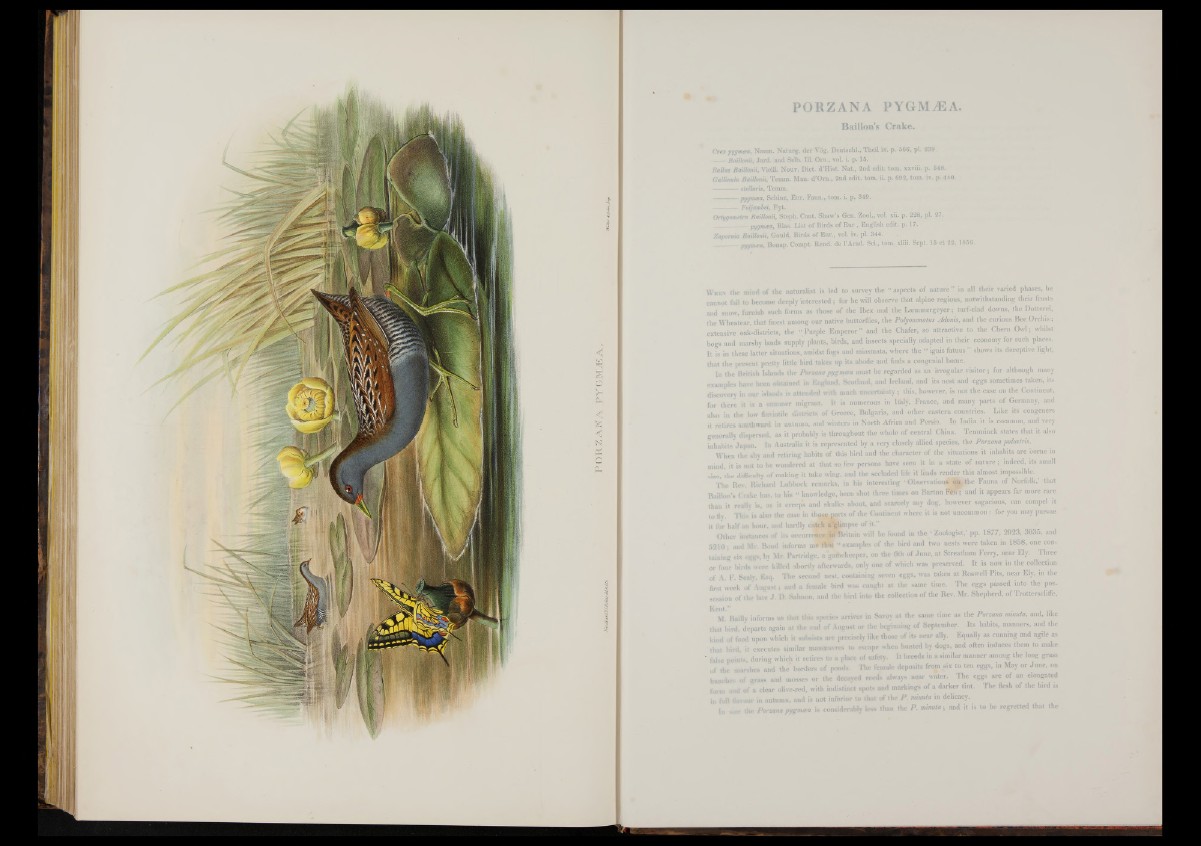
PO R Z A N A PYGML3EA,
Baiilon’s Crake.
Crex pygmaa, Naum. Naturg. der Yog. Deutschl., Theil ix. p. 566, pi. 239.
— - Baillonii, Jard. and Selb. 111. Ora., vol. i p. 15.
Rallus Baillonii, Vieill. Nouv. Diet. d’Hist. Nat., 2nd edit. tom. xxviii. p. 648.
Gallinula Baillonii, Temm. Man. d’Om., 2nd edit. tom. ii. p. 692, tom. iv. p. 440.
— atellaris, Temm.
-----------pygmaa, Schinz, Eur. Faun., tom. i. p. 349.
---------- - Foljambei, Fyt.
Ortygometra Baillonii, Steph. Cont. Shaw’s Gen. Zool.,vol. xii. p. 228, pi. 27.
' pygmaa, Bias. List of Birds of Eur , English edit. p. 17.
Zapomia Baillonii, Gould, Birds of Eur., vol. iv. pi. 344.
pygmaa, Bonap. Compt. Rend, de l’Acad. ScL, tom. xlui. Sept. 15 et 22, 1856.
When the mind o f the naturalist is led to survey the “ aspects of nature ” in all their varied phases, he
cannot fail to become deeply interested; for he will observe that alpine regions, notwithstanding their frosts
and snow, furnish such forms as those o f the Ibex and the Lteinmergeyer; turf-clad downs, the Dotterel,
the W heatear, that finest among our native butterflies, the Polyommatas Adonis, and the curious Bee Orchis;
extensive oak-districts, the “ Purple Emperor” and the Chafer, so attractive to the Chem Owl; whilst
bogs and marshy lands supply plants, birds, and insects specially adapted in their economy for such places.
I t is in these latter situations, amidst fogs and miasmata, where the “ ignis fatuus ” shows its deceptive light,
that the present pretty little bird takes up its abode and finds a congenial home.
In the British Islands the Porzana pygmata must be regarded as an irregular visitor; for although many
examples have been obtained in England. ¡Scotland, and Ireland, and its nest and eggs sometimes taken, its
discovery in our islands is attended with much uncertainty ; this, however, is not the case on the Continent,
for there it is a summer migrant. It is numerous in Italy, France, and many parts o f Germany, and
also in the low flnviatile districts of Greece, Bulgaria, and other eastern countries. Like its congeners
it retires southward in autumn, and winters in North Africa and Persia. In India it is common, and very
generally dispersed, as it probably is throughout the whole of central China. Temminck states that it also
inhabits Japan. In Australia it is represented by a very closely allied species, the Porzana palusins.
When the shy and retiring habits o f this bird and the character of the situations it inhabits are borne in
mind, it is not to he wondered a t that so few persons, have seen it in a state of nature ; indeed, its small
size, the difficulty of making it take wing, and the secluded life it leads render this almost impossible.
The Rev. Richard Lubbock remarks, in his interesting ‘ Observations on the Fauna o f Norfolk,’ that
Bailion's Crake has, to his " knowledge, been shot three times on Barton F e n ; and it appears far more rare
than it really is, as it creeps and skulks abont, and scarcely any dog, however sagacious, can compel it
to fly. This is also the case in those parts o f the Continent where it is not uncommon ; for yon may pursue
it for half aa hour, and hardly catch a -glimpse of it.”
Other instances o f its occur rente iif Britain will be found in the | Zoologist,’ pp. 1877, 292$, 3035, and
5 2 1 0 ; and Mr. Bond informs me that “ examples of the bird and two nests were taken in 1858, one containing
six eggs, by Mr. Partridge, a gamekeeper, on the 6th of June, a t Streatham Ferry, near Ely. Three
or four birds were killed shortly afterwards, only one o f which was preserved. It is now in the collection
of A. F. Scaly, Esq. The second nest, containing seven eggs, was taken a t Roswell Pits, near Ely, in the
first week of August; and a female bird was caught at the same time. The eggs passed into the possession
o f the late J . 1> Salmon, and the bird into the collection o f the Rev. Mr. Shepherd, of Trottersclifle,
i Badly informs us that this species arrives in Savoy a t the same time as the Porzana mimta, and, like
that bird, departs again at the end of August o r the beginning of September. Its habits, manners, and the
kind of food upon which it subsists are precisely like those of its near ally. Equally as cunning and agile as
that bird, it executes similar manmuvres to escape when hunted by dogs, and often induces them to make
false points, during which it retires to a place of safety. It breeds in a similar manner among the long grass
of the marshes and the borders of ponds. The female deposits from six to ten eggs, in May or June, on
bunches of grass and mosses or the deemed reeds always near water. The eggs are o f an elongated
form and of a clear olive-red, with indistinct spots and markings of a darker tint. The flesh o f the bird is
in full flavour in autumn, and is not inferior to that o f the P. mimta in delicacy.
In ,u e the Porzana p ygmea is considerably less than the P. m im ta ; and it is to be regretted that the